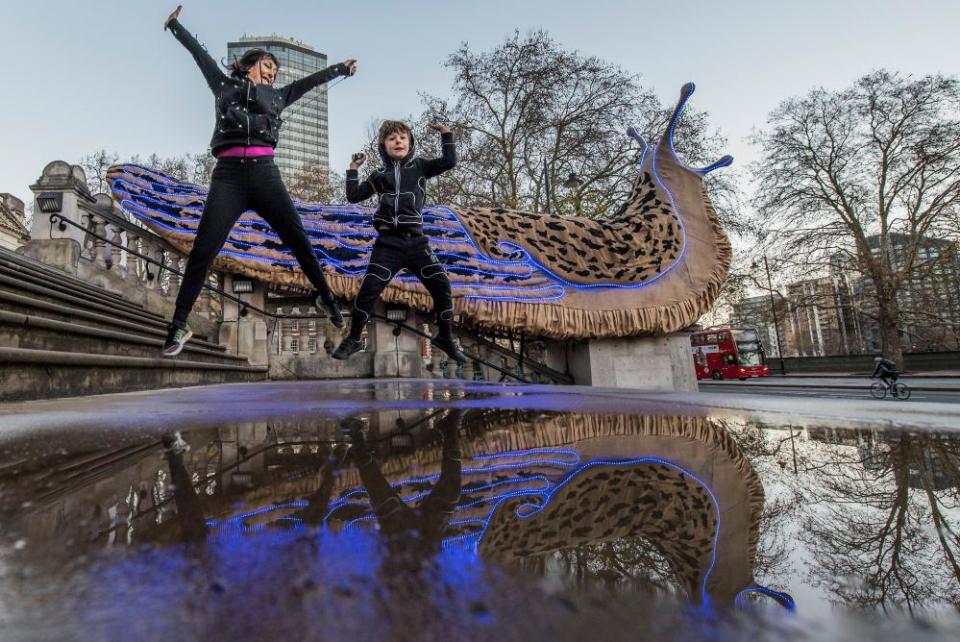Monster Chetwynd: ‘I believe in keeping morale high. Depressing people stops them taking action’

The artist Monster Chetwynd, 45, brings an odd bit of seasonal cheer to London this winter with two giant luminous slugs slithering around the main entrance of Tate Britain. Born Alalia Chetwynd, she studied anthropology before painting. Chetwynd, who changed her first name to Spartacus in 2006 and then, until recently, to Marvin Gaye, was nominated for the 2012 Turner prize. Her work combines traditional visual art with performance and video, and her handmade costumes are a trademark. She also often asks her friends and relatives to help. Chetwynd lives in Glasgow with her six-year-old son, Dragon.
Your glowing slugs have spawned a series of Christmas slime puns. Why were you drawn to these creatures?
Going for something ugly to undercut the saccharine is a good artistic formula. I aim to get at something more genuine. In the past I’ve used “earbleed” heavy metal music. And I was brought up in Australia with glow worms and so wanted to work with bioluminescence. I’m excited by the idea that one day we may be able to light things in that way.
How did Sir David Attenborough get tangled up in this artwork?
I watched his early BBC programmes and was fascinated by the footage of mating slugs. At the gallery we watched them radiating a blue light and smearing each other. We wanted to light up their snail trails too. I was more inspired by the slugs than by the horrifying images of plastic in his latest programmes.
It’s dangerous to be overtly political, and I tend to feel more at home with activists than politicians. But the more I research it, I see it has to be higher taxes to make people change their behaviour. It has to be government.

How do you make such optimistic art?
I believe in keeping morale high. If you let people believe they can do something, it’s more likely to happen. Depressing people stops them taking action. A lot of what I do is deliberately uplifting for that reason. It’s about my perspective, maybe because I was brought up Catholic. Also, I have a faith in the Greek idea of Gaia, so, to be honest, I don’t feel it’s that bad if people eventually die out. The planet may find a way to heal itself.
Was it hard to light up the slugs?
The first ideas we looked at weren’t very exciting. I wanted to use real bioluminescence but was told I could have it in a bag of water, or perhaps embed chemical bioluminescence in resin. In the end we were keen on using sustainable materials, so there’s a wooden framework, with wicker supports and hessian. There aren’t even any cable ties. There is a little nylon padding and some glue.
Another artist working in Glasgow, Charlotte Prodger, won the Turner Prize this month. What is it about that city at the moment?
It’s brilliant that Charlotte won. And, yes, there are so many Turner-nominated artists in the city. It’s so cheap and reasonable to live there, and there are a lot of people around to support you. I spotted the LED strip suits on the slugs in a parade in Glasgow and found the man who had sewn them.
You created a kind of community drama, Dogsy Ma Bone, in Liverpool two years ago. Do you prefer working like that?
There is a kind of bonding I can nurture in performances. I know the tricks. But art like that is something for a nightclub setting, or my own home, like a salon. Not for a museum.
Do you edit your ideas as they pop up?
No. It’s the same process as a conversation. I’m looking to bring up difficult subjects, like the question of cultural appropriation perhaps. Then I talk to people about it, in a crude form of market research, and use what they say. I am quite into people, even though I don’t mind if they die out.
Do your friends accept your name changes?
They are really happy to call me Monster. I’m quite engulfing now, so Monster fits. At first it was an experiment, an artistic shield. And it worked really well. Then there comes a time to change it. During Hokusai’s period in Japan, artists took different names during their lives. I was pleased to find it wasn’t just me.

 Yahoo News
Yahoo News 
